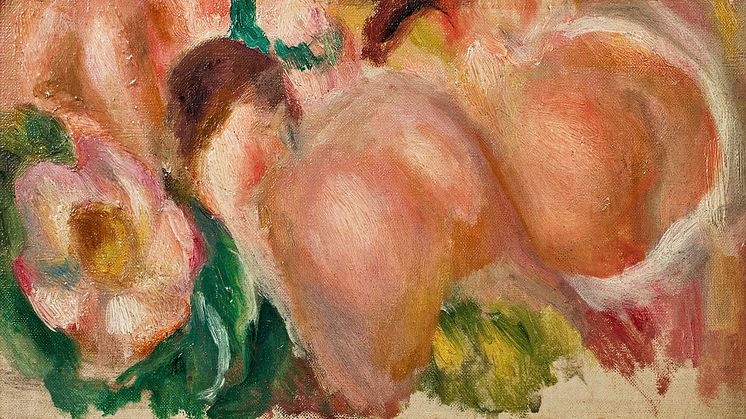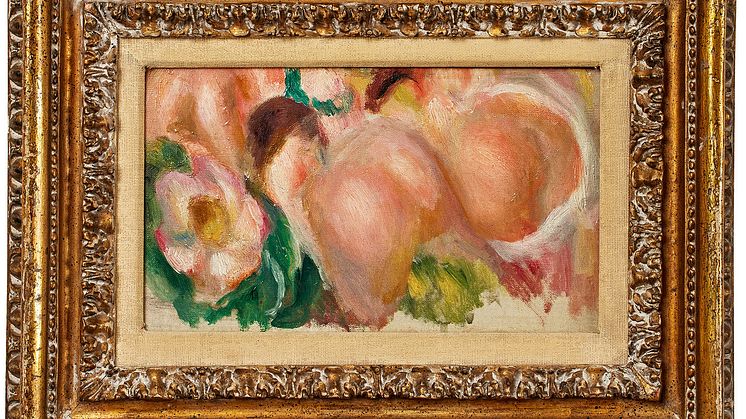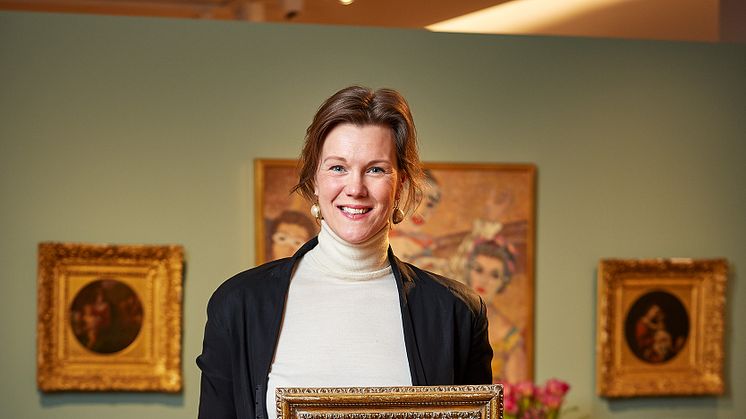
Pressmeddelande -
Rediscovered Renoir meets the world anew
A rediscovered work by the Impressionist master Renoir has been returned to its original title at Stockholms Auktionsverk, evoking the beauty of nature after spending almost 100 years in a private collection.
Bright sunlight illuminates two peaches, making their intensely yellow and pink skin shine. In a scene where plates and tablecloth may be absent, the fruits have instead fallen on a bed of flowers – a display of nature's perfection. A frozen moment from a hot summer day at Les Collettes and the artist's garden.
The last time this work by the great master Pierre-Auguste Renoir, then entitled “Deux Pêches”, saw the light of day was in 1946. When it was part of the exhibition French Art: Exhibition organized with Svenska Europahjälpen in Stockholm. Today, almost 100 years after the work was acquired in 1930s Paris, it is back on the market. The weave of colors is as vibrant now as it was then and the splendor of nature as exquisite, but the title has been adjusted. Stockholms Auktionsverk now proudly presents: “Étude de nus”.
– To sell a newly discovered work by one of the giants of art history, Auguste Renoir, is a privilege. The painting has been in the same family for almost 100 years and has not been shown to the public since the 1940s. With its tribute to female beauty, Stockholms Auktionsverk can now present it by its real name – “Étude de nus” – and once again show it to the art public, says Victoria Svederberg, Head of Art at Stockholms Auktionsverk.
Renoir was born in 1842 in the city of Limoges in western France. His father was a tailor and took the family to Paris in 1845, in the hopes of finding more work. There, Renoir became an apprentice in a porcelain studio and eventually a porcelain painter. His great aptitude and interest in painting allowed him to begin his studies at the École des Beaux-Arts in 1862. Not entirely satisfied with the school's teaching, he also studied in Charles Gleyre's studio, where he made lifelong friendships with Claude Monet, Alfred Sisley, and Fréderic Bazille.
The growing peer group of like-minded young artists sought out nature in the spirit of plein-air painting. In the Fontainebleau forest and along the Seine coastline, they developed a painting technique based on the movement of light. Subjects were captured in moments, in an ‘impression’. Landscape painting was combined with depictions of the social life that was beginning to emerge in the squares and parks of the new Paris. Renoir was the group's foremost portrayer of people and, above all, the one who was most skilled at portraying women – strangers and friends, rich and poor.
In the mid-1880s, he turned his attention back to the more mythological depictions of the female body by the great masters. From the classical sources of the Baroque painter Paul Peter Rubens and the Rococo painter Antoine Watteau, both motifs and ideals sprang mainly from the ancient pictorial world. Where women had shapes and were given space, while at the same time dancing and floating in their gestures. In Renoir's late paintings, influences from classical art are palpable. The female body was given a more generous silhouette and the imagery became more sensual, in a borderland between fantasy and reality. His color palette also became stronger, and more earthy, while his spontaneous, rhythmic brushwork became increasingly prominent again.
In 1903, Renoir moved with his own family to Cagnes, near Antibes. In a large olive grove, he built the house Les Collettes with an associated outdoor studio. It was most likely in this splendid context that “Étude de nus” was created. Its motifs depict women who can be replaced by peaches through an optical illusion. It is not impossible that Renoir has deliberately played a little joke on our visual perception. The painting is very representative of Renoir's late period with its clear heritage of classical art, in symbiosis with sketchy impressionism.
Renoir stayed away from theoretical discussions and therefore maintained purity in his pursuit of beauty. Although he was not interested in contemporary artistic developments, his late production, with works such as “Étude de nus”, acted as a bridge between the pioneering Impressionist painting and the emerging Expressionism. Renoir's importance as one of the greatest artists in the history of Western art cannot be underestimated, for the individual viewer's experience of beauty, as well as for further artistic development.
Throughout Renoir's long life as an artist, women were his main source of painterly inspiration and joy. He never tired of depicting her and continued to develop his representations of both the face and anatomy as long as he was painting. “The buttocks are the most beautiful part of a woman's body', he is said to have unabashedly stated. This study is equally unabashed, where women with buttocks and backsides smoothly transcend into the vibrant surrounding greenery. Here, beauty is celebrated in a paradisiacal motif that hovers between fantasy and reality, impossible to take your eyes off.
"Étude de nus" by Pierre Auguste Renoir will go under the gavel at the auction Fine Art & Antiques, June 14–15, at Stockholms Auktionsverk at Nybrogatan 32 in Stockholm. The auction is already published online.
Ämnen
Kategorier
Stockholms Auktionsverk är världens äldsta auktionshus och grundades 1674. Stockholms Auktionsverk genomför både slag- och onlineauktioner, och är ett av Nordens ledande auktionshus för konst, design, konsthantverk, antikviteter och böcker. Ett 60-tal experter inom olika specialområden finns på kontoren i Stockholm, Göteborg, Malmö, Helsingborg, Helsingfors, Hamburg, Köln och Düsseldorf. Stockholms Auktionsverk ägs sedan 2021 av Auctionet.com.
Bland kända kunder genom seklerna hittar man Karl XI, Gustav III, Carl Michael Bellman, August Strindberg och Selma Lagerlöf – och epoker som barock, rokoko och gustavianskt har man sålt sedan dessa var samtida.



